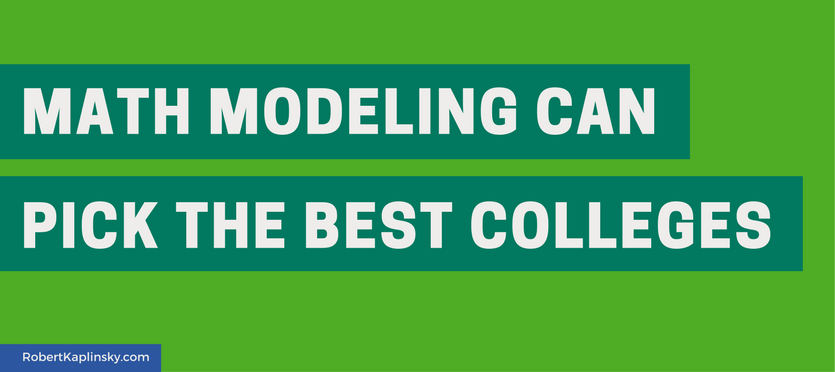[This is one of a series of posts that explore real world examples of mathematical modeling to help educators better understand its applications. This is not intended to be a context for a student lesson. To learn about Spies and Analysts, I recommend watching this webinar (with elementary, middle, and high school versions) or reading this blog post.]
You’ve probably heard of US News and World Report’s Best Colleges issue where they rank American institutions of higher education in numerical order and sell the rankings to anyone interested. Have you ever thought about how they actually determine the rankings?
If you were tasked with doing the same, how would you even begin the process? What information would you consider? Once you had that information, what would you do with it? How would you weigh the factors you looked at? This may not seem like a big deal, but it is to US News and World Report which makes millions of dollars each year from its rankings.
The process they use is called mathematical modeling. Their goal is to use mathematics to help take a complex set of information and present it in a usable format. This process is not easy and certainly not without its many criticisms. So, my goal is to open up the complexities so that we can better appreciate how mathematical modeling is used. Think of what follows as your attempt to do a better job than what US News and World Report does.
The first part of the process requires the spies. So, I want you to stop and take thirty seconds to think about what information you would use to create a better set of rankings. If my request doesn’t feel daunting to you, it should. What would you consider? SAT scores? Total number of students? Size of campus? Location? Majors offered? The list could go on and on. Once you’ve determined what information you’d want, keep reading.
- Financial resources
- Student selectivity
- SAT and ACT test scores
- Percentage of students who graduated near the top of their high school class
- Acceptance rate or the ratio of students admitted to applicants
- Graduation rate performance
- Alumni giving rate
- Graduation and retention rates
- Faculty resources
- Class size
- Faculty salary
- Proportion of professors with the highest degree in their fields
- Student-faculty ratio
- Proportion of faculty who are full time
- Undergraduate academic reputation
Now with that information at hand, what do you even do with it all? Should each component be equally important? If not, how would you weigh each one? This is where the analysts come in. Their job is to take the data and break it down in such a way that it becomes useful. Take 30 more seconds to weigh the factors listed above and then read on to see how US News and World Report weighs them.
- Graduation and retention rates (22.5%)
- Undergraduate academic reputation (22.5%)
- Faculty resources (20%)
- Class size (40% of faculty resources)
- Faculty salary (35% of faculty resources)
- Proportion of professors with the highest degree in their fields (15% of faculty resources)
- Student-faculty ratio (5% of faculty resources)
- Proportion of faculty who are full time (5% of faculty resources)
- Student selectivity (12.5%)
- SAT and ACT test scores (65% of student selectivity)
- Percentage of students who graduated near the top of their high school class (25% of student selectivity)
- Acceptance rate or the ratio of students admitted to applicants (10% of student selectivity)
- Financial resources (10%)
- Graduation rate performance (7.5%)
- Alumni giving rate (5%)
What do you think about their weightings? What do you agree with? What did they get wrong? You have to realize that if you got 1000 people in a room and had them make a list of the data and corresponding weights, there would be no duplicates.
I believe that this is the future of mathematics for our students. We can’t say that we’re creating college and career ready students when we spend years of their K-12 experience teaching them to do things that calculators can already do and are never to be used again. We need to find a way to spend more time teaching them how to do mathematical modeling, which will be a very useful skill.


This is a fantastic example for why we need to adjust our pedagogy in mathematics. We cannot continue to teach rules and procedures as our main focus and expect our students to be successful in today’s world, let alone tomorrow’s.
Well said.